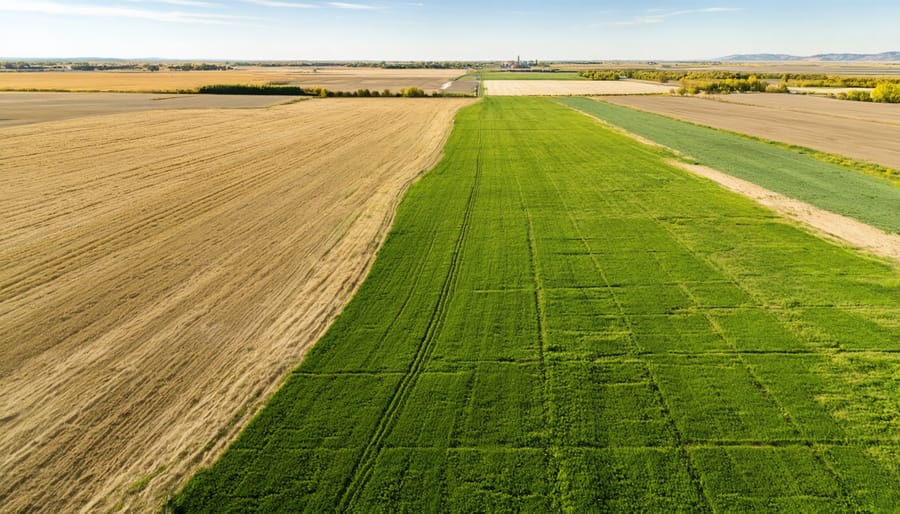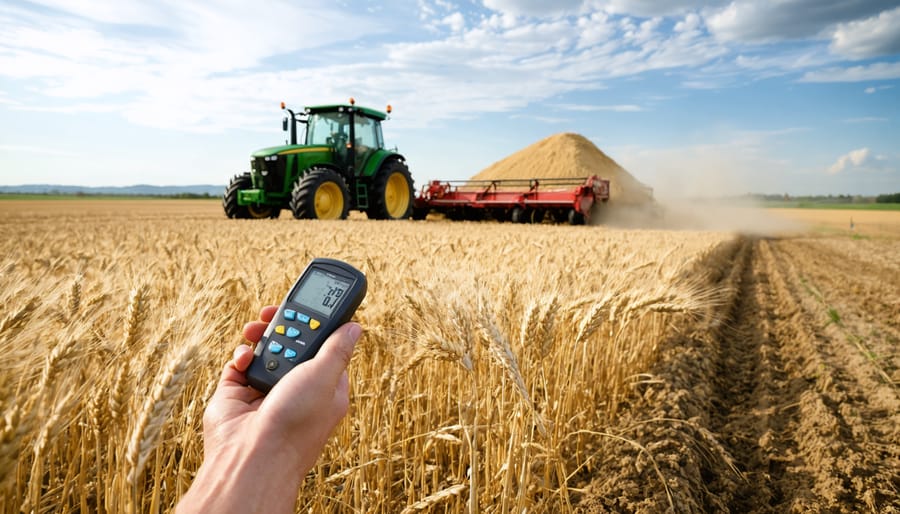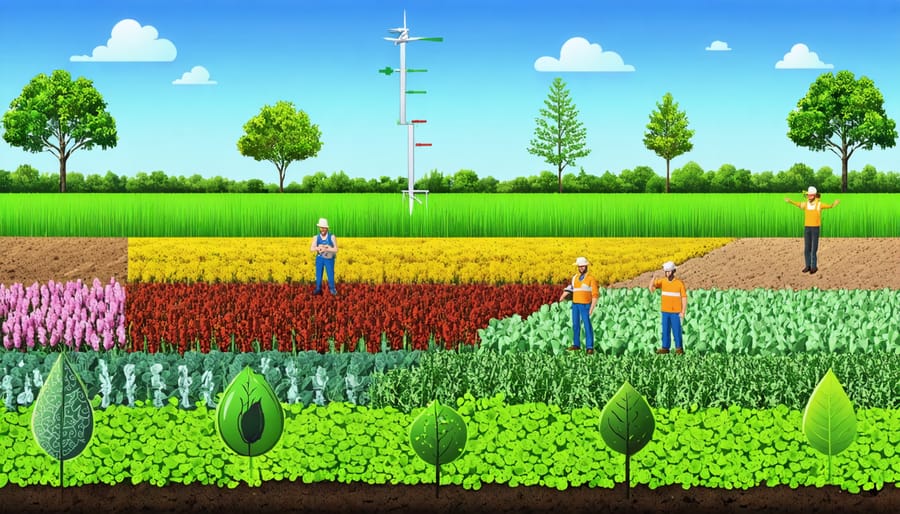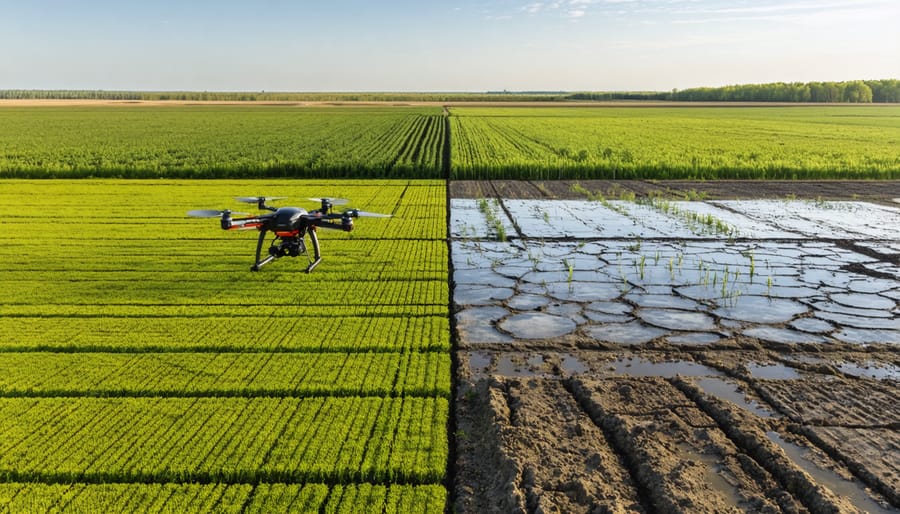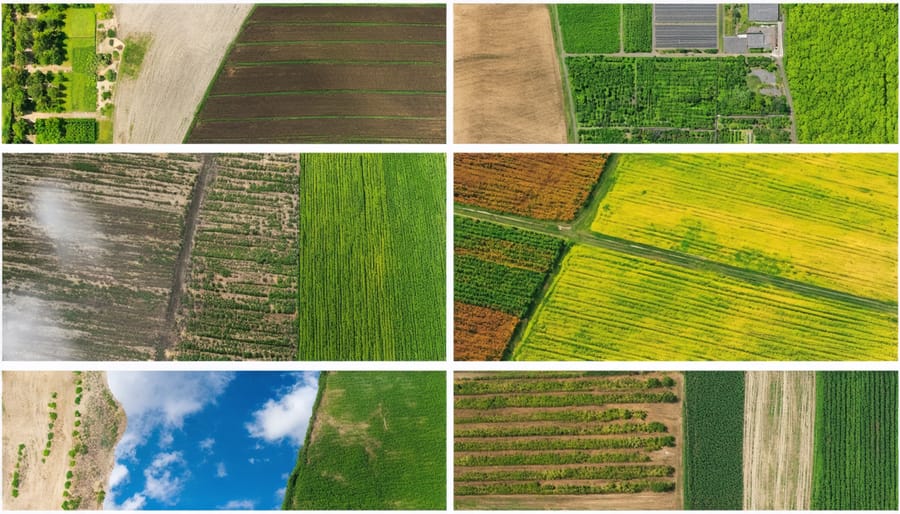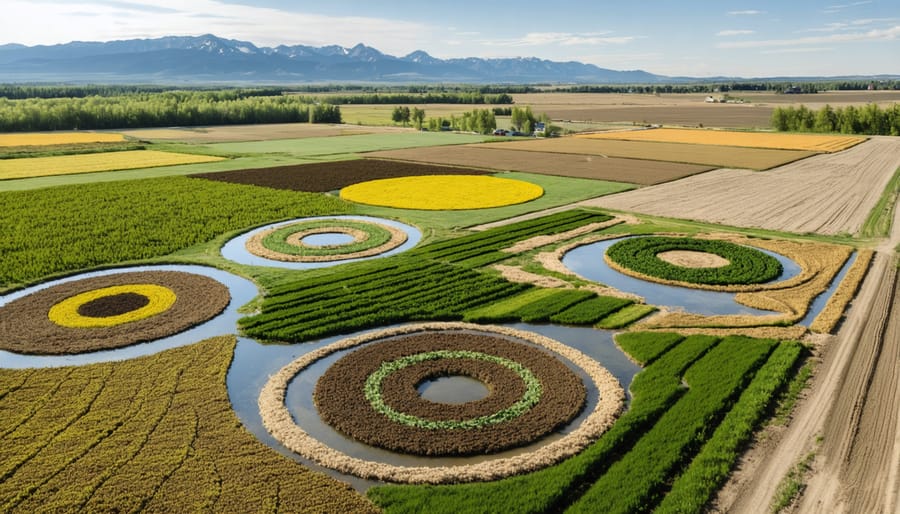Plant prairie winds grass in strategic 10-metre strips along field boundaries where prevailing winds hit strongest, creating natural windbreaks that reduce soil loss by up to 80%. Combine multiple grass varieties like blue grama and western wheatgrass to establish deep root networks, maximizing both wind resistance and long-term soil erosion prevention. Seed between late May and early June when soil temperatures reach 12°C, ensuring optimal germination rates and establishment before winter. Space rows 30 centimetres apart with a seeding depth of 1-2 centimetres to achieve the ideal 85% ground cover density required for effective wind protection.
Throughout Alberta’s prairies, this hardy perennial grass system has transformed previously vulnerable fields into resilient agricultural landscapes. Its proven success in withstanding our harsh continental climate while protecting valuable topsoil makes it an essential tool for modern Canadian farmers facing increasing wind erosion challenges.
Understanding Prairie Winds Grass
Native Species Profile
Prairie winds grass, scientifically known as Calamovilfa longifolia, is a resilient native perennial grass species particularly well-adapted to Alberta’s climate challenges. This hardy grass typically grows to heights of 1-1.5 metres, developing extensive root systems that can reach depths of up to 3 metres, making it exceptional for soil stabilization.
The grass features long, narrow leaves that roll inward during dry conditions, helping to conserve moisture. Its distinctive bluish-green colour and upright growth pattern make it easily identifiable in natural prairie landscapes. During the growing season, it produces open, spreading seed heads that catch the light, creating a striking golden appearance when mature.
Prairie winds grass demonstrates remarkable drought tolerance and thrives in sandy or well-drained soils. It begins growth early in spring, typically emerging when soil temperatures reach 10°C, and maintains its structure throughout winter, providing year-round erosion protection.
One of its most valuable characteristics is its ability to spread through both seeds and underground rhizomes, allowing it to establish dense stands that effectively combat wind erosion. The grass maintains its upright position even under heavy snow loads, making it particularly effective for winter wind protection in agricultural settings.
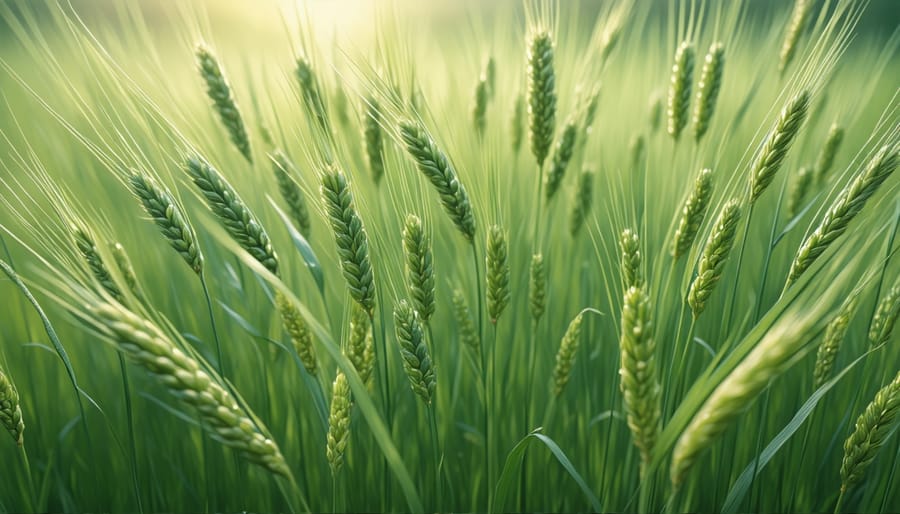
Root System Benefits
Prairie winds grass develops an extensive root system that can reach depths of up to 2 metres, making it an exceptional choice for soil stabilization in Alberta’s challenging climate. These deep roots create a complex underground network that effectively binds soil particles together, significantly reducing the risk of wind erosion – a common concern for farmers across the prairie provinces.
The root structure features both deep tap roots and spreading lateral roots, providing a dual approach to soil stability. This comprehensive root system helps break up compacted soil layers, improving water infiltration and soil structure over time. During dry periods, the extensive root network allows the grass to access moisture stored deep in the soil profile, contributing to its remarkable drought resistance.
Beyond erosion control, the root system of prairie winds grass delivers additional benefits to your soil ecosystem. As roots naturally die and decompose, they add valuable organic matter to the soil, enhancing its fertility and water-holding capacity. This process also creates channels for water movement and supports beneficial soil microorganisms.
Many Alberta farmers have observed improved soil structure within two to three growing seasons after establishing prairie winds grass. The root system’s ability to penetrate hard soil layers makes it particularly valuable for rehabilitating degraded farmland and protecting vulnerable areas from wind damage. This natural soil-binding capability makes it an excellent choice for field borders, windbreaks, and other areas prone to erosion.
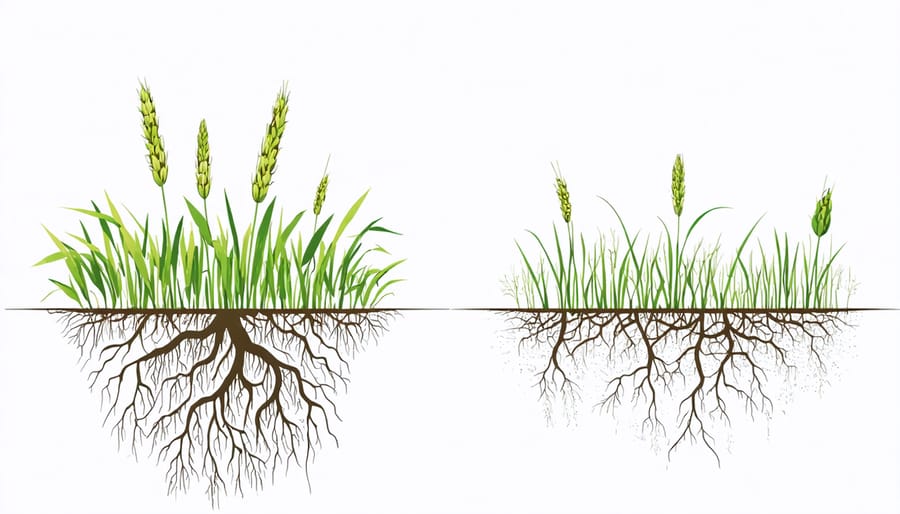
Implementing Prairie Winds Grass in Your Fields
Planting Strategies
In Alberta’s climate, successful establishment of prairie winds grass requires careful timing and preparation. The optimal planting window falls between mid-May and early June, when soil temperatures consistently reach 10°C and the risk of late spring frosts has passed. This timing allows seedlings to develop strong root systems before winter.
Before planting, prepare a firm, weed-free seedbed with good moisture retention. The soil should be worked to a depth of 2-3 cm, creating an environment where seeds can make solid contact with the soil while remaining close to the surface. A common practice among Alberta farmers is to use a cultipacker before and after seeding to ensure proper seed-to-soil contact.
Seeding rates typically range from 5-7 kg/ha when planting pure stands. For mixed plantings with other native species, reduce this rate by 25-30%. Plant seeds at a shallow depth of 1-1.5 cm – remember the old farmer’s wisdom: “Plant it shallow enough to still see a few seeds on the surface.”
Fall dormant seeding can also be successful when done between October 15 and freeze-up. This method takes advantage of early spring moisture and natural cold stratification, though success rates can be more variable than spring planting.
Monitor moisture levels closely during the establishment phase. While prairie winds grass is drought-tolerant once established, adequate moisture during the first 6-8 weeks is crucial for successful germination and early growth.
Maintenance Requirements
Prairie winds grass requires consistent but manageable maintenance throughout the year to ensure its effectiveness in controlling wind erosion. During the growing season (May to September), regular monitoring of grass height is essential, with optimal grass maintenance keeping the height between 10-15 centimetres.
Spring maintenance involves removing dead vegetation and assessing winter damage. Light harrowing can help promote new growth, but avoid aggressive cultivation that might disturb the root system. Apply fertilizer only if soil tests indicate deficiencies, as prairie winds grass typically thrives in native soil conditions.
Summer care focuses on weed control and moisture management. While this grass variety is drought-tolerant, supplemental watering during extended dry periods helps maintain density. Spot-treating weeds is preferable to broadcast herbicide application to preserve beneficial insects and soil health.
Fall preparation is crucial for winter survival. Allow the grass to grow slightly taller (15-20 centimetres) before winter to protect crown tissue. Avoid heavy equipment traffic when soil is wet to prevent compaction.
Winter typically requires minimal intervention, as prairie winds grass is well-adapted to Alberta’s climate. However, monitor for snow mold in early spring, especially in areas where snow accumulation is heavy. Recording seasonal maintenance activities helps track the grass’s performance and adjust care strategies for optimal results.
Integration with Existing Crops
Prairie winds grass integrates seamlessly with existing agricultural systems, making it an ideal companion crop for Alberta farmers. The grass can be strategically planted in strips between traditional crop rows or along field boundaries, creating natural windbreaks without significantly impacting productive farmland.
For grain farmers, incorporating prairie winds grass in 10-metre buffer zones around field perimeters provides excellent wind protection while maintaining easy access for equipment. These buffer zones can reduce wind velocity by up to 40% across adjacent cropland, significantly decreasing soil erosion and protecting young plants.
Many Alberta farmers have found success with a phased integration approach. Starting with small test areas of 1-2 hectares allows for observation of how the grass interacts with existing crops and soil conditions. The grass’s deep root system actually benefits nearby crops by improving soil structure and water retention, creating a mutually beneficial relationship.
Livestock producers can integrate prairie winds grass into pasture rotation systems. The grass provides excellent forage quality while serving its protective function. When planted in strategic strips across pastureland, it creates sheltered areas for cattle during harsh weather conditions.
For optimal results, timing the planting of prairie winds grass is crucial. Early spring seeding, just before the typical rainy season, gives the grass the best chance to establish itself while minimizing competition with other crops. Most farmers report successful establishment within one growing season, with full wind protection benefits visible by the second year.
Real Results from Alberta Farms
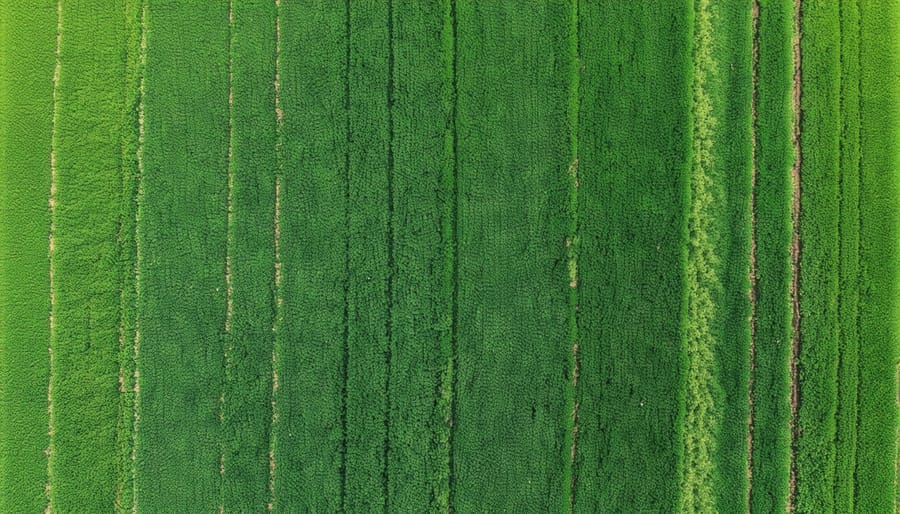
Southern Alberta Success Story
Tom Anderson’s farm near Lethbridge stands as a testament to the transformative power of prairie winds grass in combating wind erosion. Five years ago, his 800-hectare operation faced severe topsoil loss, with spring winds regularly creating dust storms that threatened both his crops and soil health.
“I was losing precious topsoil every spring, and traditional shelterbelts weren’t providing enough protection,” Tom recalls. “After consulting with our local agricultural extension office, we decided to implement prairie winds grass strips across our most vulnerable fields.”
Tom planted 10-meter-wide strips of prairie winds grass at 200-meter intervals across his wheat fields. The installation process took two growing seasons to establish fully, but the results were worth the wait. “The grass reached maturity faster than expected, and by the third season, we noticed a significant reduction in soil movement during high-wind events.”
The impact has been measurable. Soil testing shows improved organic matter retention in protected areas, and Tom estimates a 70% reduction in visible dust during spring winds. Moreover, the grass strips have created wildlife corridors, supporting beneficial insects and birds that help with natural pest control.
“The initial investment was approximately $200 per hectare, including seeds and labor,” Tom shares. “But when you consider the long-term benefits of soil preservation and reduced input costs, it’s been one of our best farming decisions.”
Tom’s success has inspired neighboring farms to adopt similar practices, creating a growing network of wind-resistant agricultural landscapes across southern Alberta. He now hosts regular field days, sharing his experience with other farmers looking to protect their soil heritage.
Economic Benefits
The implementation of prairie winds grass offers substantial economic benefits for farmers through both immediate cost reductions and long-term soil preservation. Many Alberta farmers report saving between $75 and $150 per hectare annually on soil remediation costs after establishing prairie winds grass barriers. These savings stem from reduced need for emergency tilling and decreased soil amendment requirements.
The grass’s deep root system helps maintain topsoil integrity, preventing the loss of valuable nutrients that would otherwise need replacement through costly fertilizers. Local studies show that fields protected by prairie winds grass retain up to 85% more topsoil during high-wind events compared to unprotected areas, translating to significant savings on soil replacement and enhancement.
Prairie winds grass also contributes to moisture retention, potentially reducing irrigation needs by 20-30% in protected areas. This water conservation aspect becomes particularly valuable during drought conditions, helping farmers maintain crop yields while minimizing water-related expenses.
Furthermore, the grass serves as a natural snow fence during winter months, promoting even snow distribution across fields. This natural moisture management can save farmers approximately $200-300 per kilometer on artificial snow fence installation and maintenance while providing better coverage for winter wheat and other cold-season crops.
The initial investment in prairie winds grass typically pays for itself within 2-3 growing seasons through reduced soil management costs and improved crop yields in protected areas. Many Alberta farmers have documented 15-25% higher yields in fields sheltered by prairie winds grass, particularly during challenging weather conditions.
Prairie winds grass stands as a testament to nature’s ingenuity in protecting our valuable agricultural lands. Throughout this exploration, we’ve seen how this remarkable plant species offers multiple benefits for Canadian farmers, particularly in Alberta’s wind-prone regions. From its robust root system that anchors soil in place to its ability to thrive in challenging conditions, prairie winds grass proves to be an invaluable ally in the fight against wind erosion.
The implementation of prairie winds grass into existing agricultural operations represents more than just erosion control – it’s an investment in sustainable farming practices that benefit both the land and future generations. By incorporating this native species into windbreaks and buffer zones, farmers can create resilient landscapes that protect crops while supporting local biodiversity.
The success stories shared by Alberta farmers who have already adopted prairie winds grass in their operations demonstrate its practical value. These early adopters have reported significant reductions in soil loss, improved moisture retention, and enhanced overall farm sustainability. Their experiences provide a roadmap for others looking to implement similar solutions.
As our climate continues to change and wind patterns become more unpredictable, the importance of natural erosion control methods cannot be overstated. Prairie winds grass offers a cost-effective, environmentally friendly solution that aligns with both traditional farming wisdom and modern agricultural practices.
We encourage farmers and agricultural professionals to consider incorporating prairie winds grass into their land management strategies. Local agricultural extension offices and conservation authorities stand ready to provide guidance and support for implementation. By working together and sharing experiences, our farming community can build more resilient agricultural landscapes that will serve us well into the future.
Remember that every step toward sustainable land management, no matter how small, contributes to the broader goal of preserving our precious prairie soils for future generations. The time to act is now, and prairie winds grass offers a proven path forward in our collective effort to protect and enhance Canadian agricultural lands.

